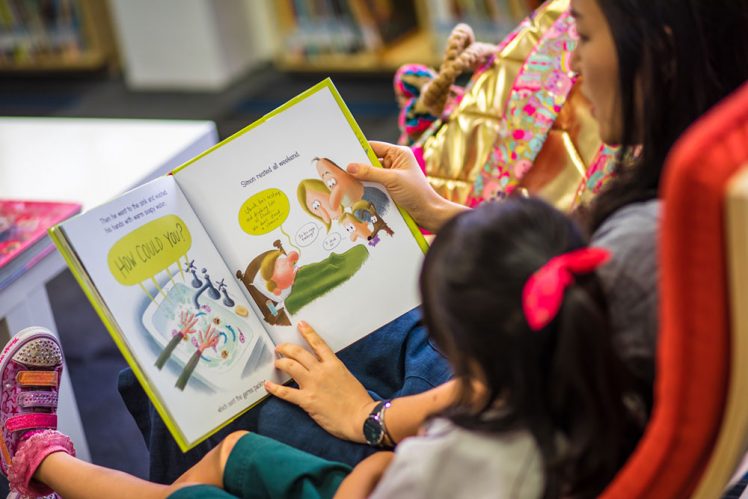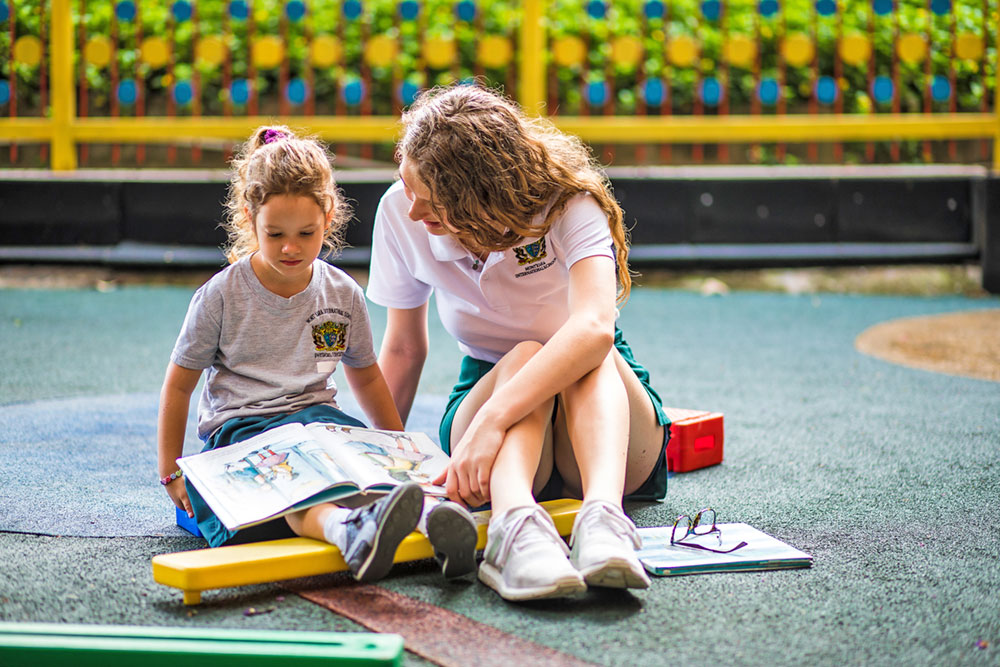Literacy is always a hot topic among parents. Parents feel like they need to be doing more, but are not always sure about how to go about supporting their young readers. They believe they need to be the “teachers” of reading, however, supporting your child’s reading development at home is much easier than most expect. The answer is quite simply – to read!
As educators and parents, we have found that there are four simple strategies to support your child’s literacy development at home:
Read Aloud to Your Child

Numerous studies have shown that reading to your child is the single most important activity for building the knowledge required for success in reading. It sounds simple, but it’s true! Read often and regularly. Reading aloud allows your child to hear and see a fluent reader. They see what reading looks like and sounds like. Reading aloud also exposes your child to rich vocabulary and allows them to enjoy books are too challenging for them to read independently.
Reading to your child should start in infancy and can continue into adolescence. Yes, reading to your teenager can actually help them to continue to grow as a reader and can even improve their test scores! Reading aloud doesn’t and shouldn’t stop once your child becomes a reader. The Scholastic Kids and Family Reading Report indicates that 40% of children (ages 6-11) whose parents no longer read to them wished their parents continued reading aloud to them because they enjoyed the special time with their parents and it was fun!

You can make reading times more engaging by having your child read to you, you read to them or you take turns reading one page at a time. Reading aloud to your child also allows you to provide a guided choice about what your child is reading. Let them choose from several options you’ve selected together. Try to choose from a variety of genres and topics; expose them to different types of texts and include books in different languages, if appropriate. Letting your child choose an appropriate book with your guidance is also an option.
Provide a Literacy-Rich Home

Ensure there are plenty of reading materials at home, and make them accessible! Keep them in a place where they can be reached and accessed at any time. Books, magazines, and newspapers are not the only sources you can use. You can also use your school or local library in order to provide a large range of texts. According to the Educational Testing Service, the variety and amount of reading materials in homes has a significant impact on children’s interest in reading and reading proficiency. Playing games that require reading, cooking together while reading recipes, looking at instruction manuals when working on a project together are all real-life examples that require reading and they’re fun!
Be a Model & Talk About Reading

Let your child see you enjoy reading too! When children see a trusted and loved adult seek out reading in their daily life, it sends the message that reading is fun and important. Furthermore, it avoids the “do as I say, not as I do” scenario. If you’re reading an interesting article, talk to your child about it. If there’s a suspenseful or humorous part of your book, tell them about it.
Similarly, ask them about what they are currently reading, whether it’s reading done at school or at home. Ask them about the types of texts they like to read. Get them to talk about their book with you to help build their comprehension. Consider asking about the plot of the story, the characters, the moral/lesson, and have them make predictions and connections to their own life and the world but also, you can have simple and natural conversations that show you are interested and curious about what they are reading.
Establish a Routine

Make your reading time together a routine and make it fun! Many families have a family reading time in which they all sit and share a story together. Create a special place and time to read together each night. It might be snuggled up in bed or under a blanket on the couch. Don’t allow for outside interruptions. Make it clear that this time together is valuable and precious.
As you can see, these four simple strategies are easy to implement at home in order to support your child’s reading growth. Most importantly, have fun reading at home. Ultimately, the goal is to make reading an enjoyable experience, one that both develops your child’s literacy skills and encourages them to become lifelong readers.
————————————————————————————————————–
Co-written by:
Christina Laukaitis, Elementary Literacy Support Teacher, Mont’Kiara International School
Dawn Brews, Elementary School Assistant Principal and PYP Coordinator at Mont’Kiara International School
References:
Educational Testing Service, 1999. America’s Smallest School: The Family.
Scholastic, 2015. Scholastic Kids and Family Reading Report 5th Edition.
"ExpatGo welcomes and encourages comments, input, and divergent opinions. However, we kindly request that you use suitable language in your comments, and refrain from any sort of personal attack, hate speech, or disparaging rhetoric. Comments not in line with this are subject to removal from the site. "























